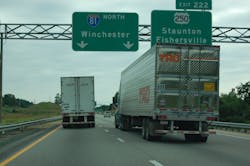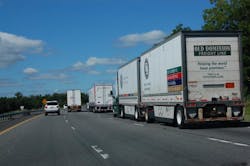Rick Mihelic, president of Mihelic Vehicle Consulting, made an interesting point the other day while discussing the future of electric trucks in a conference call hosted by Stifel Capital Markets: There is no free ride in the freight business, because, at the end of the day, you’ve got to be able to make a profit hauling goods from Point A to Point B.
And therein lays the challenge facing not just electric trucks but any new technology trying to enter the trucking market.
“Ultimately, new technology requires a positive return on investment to gain market share,” Mihelic noted.
“In the short term, though, incentives, tax breaks, grants, et cetera, may offset the technical costs to make a new technology relatively cost neutral versus existing systems,” he emphasized. “But, in the long run, for any significant market penetration, the efficiency gains and cost savings must materialize to offset those additional costs.”
That isn’t to say electric trucks or other new technologies face insurmountable odds, Mihelic pointed out. Indeed, he stressed that “revolutionary change” has occurred in transportation before – upending not just technology but almost every aspect of freight operations as well.
“A good example is the 1940s when coal- and oil-fired steam train systems were replaced by diesel electric ones,” Mihelic explained.
“There were a lot of domino effects beyond just the change in the engines. If you think back, coal and water stations were located based on what the engines required, not based on what the market needed,” he said. “So, when diesel electric engines came along, those stations disappeared and they were relocated based on market demand for the operations rather than the equipment: Routes changed; maintenance and operator skill sets changed significantly, as did the maintenance intervals; parts distributors changed and OEMs changed; even the residual value of those capital investments changed.”
Thus any change to future freight cost models – whether they be based on truckers powered by electricity, natural gas, or some form of cleaner diesel – will need to deal with new factors in vehicle obsolescence, driver obsolescence, vehicle maintenance, driver and technician training, technology investment, information technology, insurance, effective tax costs (sales, excise, and use), new infrastructure investment, and basic infrastructure maintenance, Mihelic stressed.
“All of those things will be changing in the cost model,” he said.
That means that many of the “rules of thumb” that govern the trucking industry today may be due for a serious overhaul.
“Trucking carries about 65% of the freight in the U.S. and it will for the foreseeable future,” Mihelic noted. “There is an inventory of three to four trailers for every single tractor that’s moving. One third of the cost is typically associated with the driver, a third is associated with fuel, and a third is associated with equipment costs. Another key factor is that freight per vehicle is increasing, so there is more payload per vehicle, but the annual miles that each of those vehicles is driving is declining.
Yet those “rules of thumb” are not given, he emphasized.“Some of them are assumptions and they can and will change based on innovation in the entire freight space,” Mihelic pointed out. “The freight system encompasses many opportunities for innovation. It’s not just the tractor and it’s not a single truck with a trailer. The opportunity space includes everything associated with freight hauling. That includes multiple trailers, it includes traffic and congestion, time at the factory, the warehouse, the energy source in the network, the regulations, and, very importantly, it includes the driver and many other factors.”
Thus, from where he sits, Mihelic said freight innovations are now poised to move beyond the “self-imposed constraint” of redesigning a single semi-truck. Rather, the focus will be on improving the whole freight system.
“It’s a different question entirely,” he explained.
It is indeed. And it will be interesting to see how answering may transform the trucking industry.


